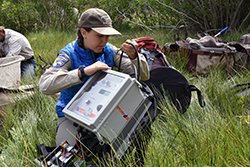
CDFW Scientific Aide Aimee Taylor prepares electrofisher to harmlessly catch Paiute cutthroat trout in North Fork Cottonwood Creek.
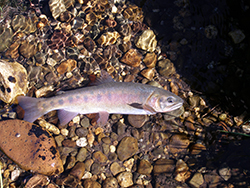
The extremely rare Paiute cutthroat trout (PCT). Photo by William Somer for CDFW.
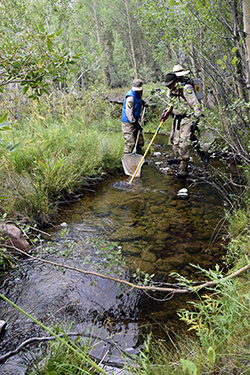
Aimee Taylor and Senior Environmental Scientist Jeff Weaver electrofish PCT in North Fork Cottonwood Creek.
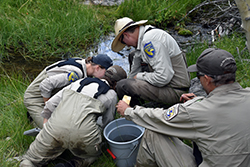
Jeff Weaver, USFWS Biologist Chad Mellison and others take genetic samples from the fish.
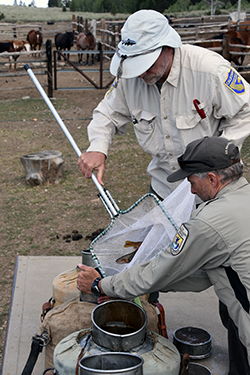
The project’s lead biologist, Bill Somer, and Chad Mellison transfer the trout from CDFW’s tank truck to cans for the ride to Silver King Creek, by pack mule.
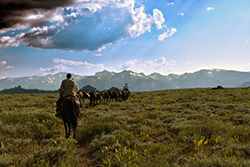
The CDFW-FWS-USFS team packs pure PCT in milk cans through the Silver King drainage.
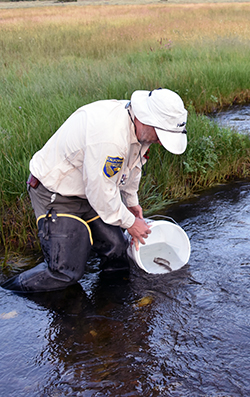
Bill Somer releases Paiute cutthroat trout into Silver King Creek, above Llewellyn Falls.
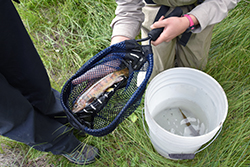
Team members measured each Paiute cutthroat trout caught at White Mountain.
The California Department of Fish and Wildlife (CDFW), U.S. Fish and Wildlife Service (FWS), and U.S. Forest Service (USFS) have returned a rare trout species to its home water after a 71-year absence.
In 1946, poachers were decimating the Paiute Cutthroat Trout (PCT), a species whose native range was limited to a nine-mile section of Silver King Creek (Alpine County). To ensure the species’ survival, the USFS and Eastern Packers Association translocated 401 of these fish to North Fork Cottonwood Creek in Inyo County’s White Mountains. This population has persisted in isolation from other forms of trout and has recently provided important restoration options for resource managers. None of this would have been possible without the foresight of concerned biologists seven decades ago.
The conservation history of this rare trout is complex. The initial “conservation” measure was entirely inadvertent. In the early 1900s, Basque sheepherders in the area caught and transported PCT into the previously fishless portion of Silver King Creek above Llewellyn Falls. This early within-basin transfer was the salvation of the PCT, since non-native species were later introduced below the falls. The falls prevented non-natives from reaching the habitat above and protected PCT from hybridization and competition.
The FWS listed PCT as endangered under the Endangered Species Preservation Act of 1966 – the precursor to the federal Endangered Species Act (1973). The species was down-listed to threatened status in 1975, in order to facilitate management and restoration and to allow regulated angling. In 1994, CDFW, FWS and USFS began developing a restoration plan to remove non-native fishes from Silver King Creek and return the PCT to its native waters. From 2013 to 2015, the partner agencies treated 11 stream miles of Silver King Creek and three tributaries below Llewellyn Falls with a fish toxicant, rotenone, to remove all non-native fish species.
The PCT population in Upper Fish Valley, an area of Silver King Creek above the falls, has been considered a primary source for restocking the recovery area. Unfortunately, that population was heavily impacted by the extreme 2012-2016 drought. During this extended drought, lack of snow cover resulted in the stream freezing almost solid during cold snaps. In order to offset the resulting population decline, the partner agencies caught 86 pure PCT in North Fork Cottonwood Creek. On August 23, 2017, the fish were planted back into Silver King Creek above Llewellyn Falls.
Agency staff met in the White Mountain Wilderness (Inyo National Forest) and, along with volunteers and pack mules, hiked from their campsite to North Fork Cottonwood Creek. There, the team used electrofishers to retrieve descendants of the fish moved back in 1946. The fish were hauled out by mule, put in a specialized transport truck, and driven approximately 100 miles to the Carson Iceberg Wilderness. Another mule team then hauled them back to Silver King Creek. Thanks to careful handling by the collection and transport teams, every fish survived the trip home.
Due to its limited habitat, the Paiute Cutthroat Trout has been called the rarest, but most recoverable, form of trout in the United States. With the most recent success of this partnership, and due in large part to the foresight of conservationists in the past, the future looks bright for this beautiful native salmonid.
Learn more on the Paiute cutthroat trout web page.
Photos by Joe Barker, courtesy of U.S. Fish and Wildlife Service, except as noted.
Top photo:
Liz Vandentoorn, from the Inyo National Forest Region 5 Center of Excellence, leads a pack mule team and state and federal scientists to North Fork Cottonwood Creek to capture Paiute cutthroat trout and return them to Silver King Creek.